Traveling Through Rome…By the Book
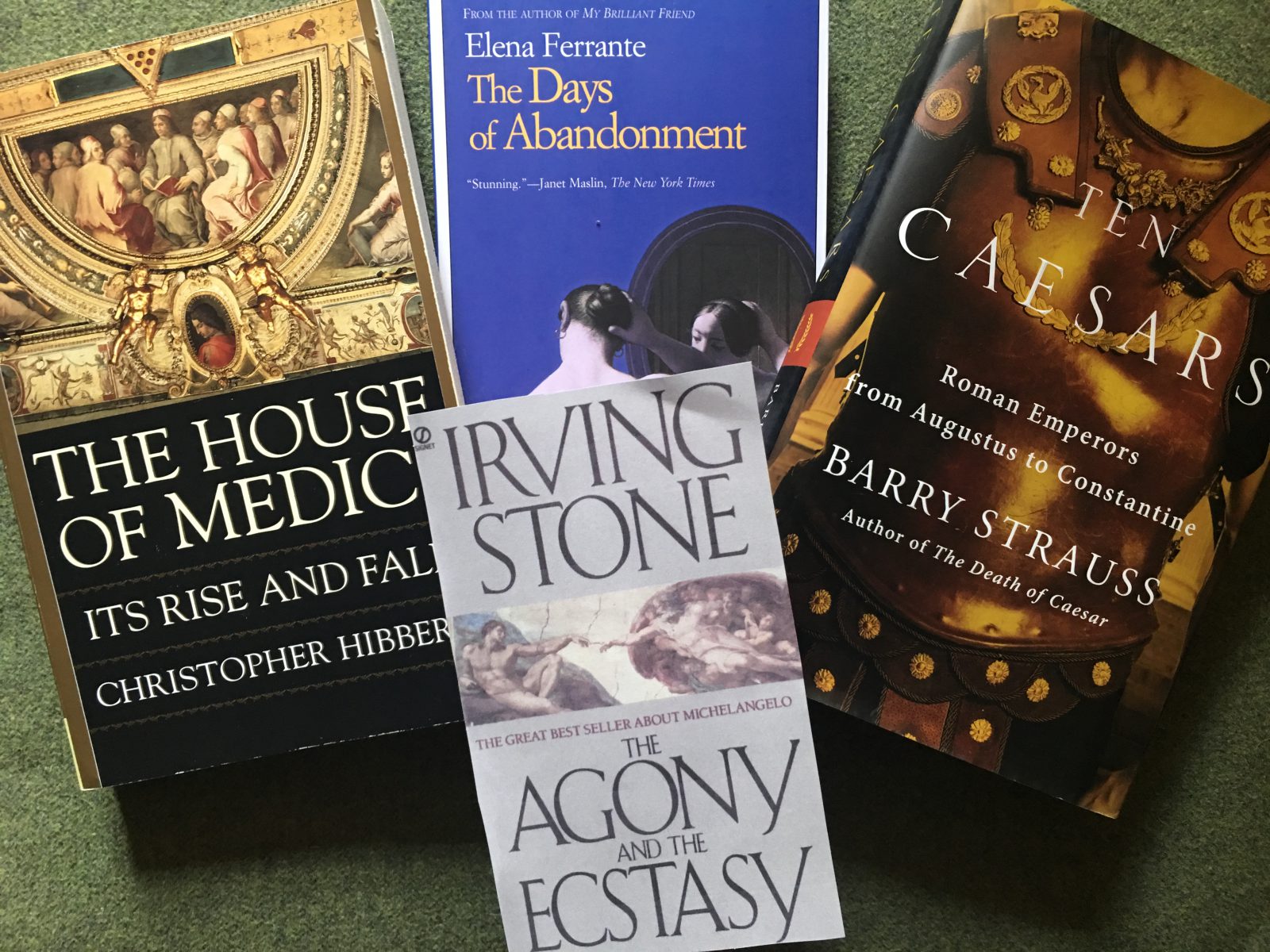
My best friend from college is Italian, and I am fortunate to have visited her and her family many times in Rome and throughout Italy over the years. Although we’ve explored most of the country, Rome remains one of my favorite cities. I spent 10 days there recently and didn’t really need a guidebook— just an excellent map and my own research. Come explore with me as I travel by the book through the rise of the Roman Empire and the artistic genius of the Renaissance while tapping into contemporary life in this vibrant city.
The best places to begin to appreciate the Roman Empire are the Forum, Colosseum and Palatine Hill. This is where the action was (and still is, touristically speaking). The Colosseum is magnificent, and I was lucky enough to see it in the distance every single day as I hopped off the tram at Piazza Venezia. Made of travertine, tuff and brick-faced concrete, it is the largest amphitheater ever built. Construction of this remarkable innovation began under Emperor Vespasian (69-79) in 72 and was finished by his successor, Titus (79-81), the first emperor to come to the throne after his own biological father.
According to Barry Strauss, author of Ten Caesars, a collection of mini biographies that provide tremendous color and detail of key emperors from the founding by Augustus to the Christianizing by Constantine, public works were one of the ways that emperors boosted their standing with the people. Thus, a place where 50,000 spectators could watch gladiatorial games was monumental. So, too, were the nearby Arch of Constantine and Forum, best viewed from the Palatine Hill, where the emperors’ palaces were built, rebuilt and expanded upon over the years. Standing on the hill overlooking the ruins, one can imagine the intrigue taking place almost two thousand years ago among the various emperors and senators in a frenzy of politics, history and political drama.
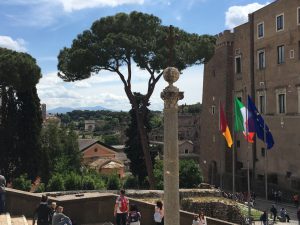
View of the Roman Forum, Palatine Hill and Constantine’s Arch.
Ten Caesars lays bare how difficult life was at the time: the rich and powerful could be swept up in a plot, leaving murder and suicide as the only ways out. Poor decisions by emperors could lead to famine while disease decimated a family or town. Slaves could die fighting for their freedom; women could take on immense power behind the throne.
And the statues! They are, literally, all over Rome. The most economical (time and euros) way to see the best collection of statues is to buy two different tickets. The two-part Capitoline Museums house iconic pieces of art and history, including famous statues of emperors (see photos). The four-part Roman National Museum allows visitors entry to Palazzo Massimo, which houses one of the best archaeological collections in the world; Palazzo Altemps, a 16th-century palace with a bust of every Caesar and “finished” statues (preservationists added a hand, foot, nose, arm to the otherwise fractured statues); Crypta Balbi, which takes one back to the time of Augustus (27 BC-14 AD), the founder; and the Baths of Diocletian (284-305), known as the great divider.
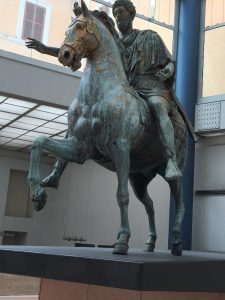
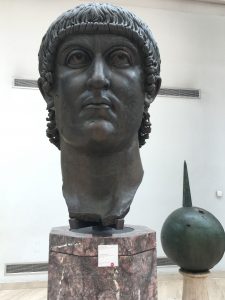
The head remnant of the 40-foot high Colossus of Constantine (306-337), who is known as “liberating” the Roman people through Christianity.
Fast forward from Constantine to the Italian Renaissance which began in the 14th century: The Agony and the Ecstasy, historic fiction that was a best seller by Irving Stone written in the 1970s, provided rich, colorful details about Michelangelo’s struggles with his art, money and the politics of the Roman Catholic Church. The House of Medici: Its Rise and Fall, by Christopher Hibbert, provided historic context and a glimpse into the role both power and money played as the city-states within Italy fought each other for land, power and influence. Michelangelo and the Medici family were from Tuscany and Florence, as well as paramount to the blossoming of artistic and architectural masterpieces commissioned by the Church.
The Agony and the Ecstasy describes how Michelangelo was taken under the wing of the Medici family when he was a teen. It was during this time that he honed his sculpting skills, met fellow artists and learned the art of fresco painting (the Sistine Chapel, located in the Vatican Museum, is probably the most famous fresco in the world).
So instead of revisiting tourist-thronged St. Peter’s, which is bursting with masterpieces and crowds, I spent days wandering the streets of Rome visiting dozens of churches and admiring the immense beauty to be found inside the cool buildings that were usually not very crowded.
Fast forward from Constantine to the Italian Renaissance which began in the 14th century: The Agony and the Ecstasy, historic fiction that was a best seller by Irving Stone written in the 1970s, provided rich, colorful details about Michelangelo’s struggles with his art, money and the politics of the Roman Catholic Church. The House of Medici: Its Rise and Fall, by Christopher Hibbert, provided historic context and a glimpse into the role both power and money played as the city-states within Italy fought each other for land, power and influence. Michelangelo and the Medici family were from Tuscany and Florence, as well as paramount to the blossoming of artistic and architectural masterpieces commissioned by the Church.
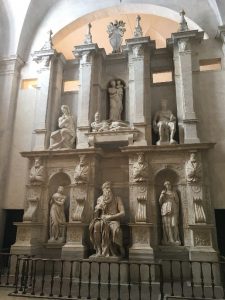
Michelangelo considered this Moses, which adorns the Tomb of Pope Julius II in San Pietro in Vicoli, to be one of his best creations.The Agony and the Ecstasy describes how Michelangelo was taken under the wing of the Medici family when he was a teen. It was during this time that he honed his sculpting skills, met fellow artists and learned the art of fresco painting (the Sistine Chapel, located in the Vatican Museum, is probably the most famous fresco in the world).
So instead of revisiting tourist-thronged St. Peter’s, which is bursting with masterpieces and crowds, I spent days wandering the streets of Rome visiting dozens of churches and admiring the immense beauty to be found inside the cool buildings that were usually not very crowded.
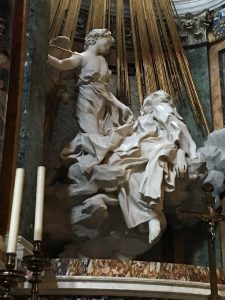
The Stasi of Santa Theresa in Santa Maria della Vittoria, by Bernini, is probably his most famous and magnificent.
Being surrounded by statues, paintings and the ruins of an empire long past can be exhausting, particularly because one’s studies can go on and on. So I spent many evenings reading The Days of Abandonment by Elena Ferrante, one of Italy’s most famous contemporary novelists. It catapulted me into the present where I enjoyed many discussions about relationships, marriage, economy, politics, literature, lifestyles, taxes, education, Brexit—and more!—over pinsa e pizza and a bottle of wine one evening, enjoying the delicacies of a mozzarella bar one afternoon, and walking, talking and eating gelato.
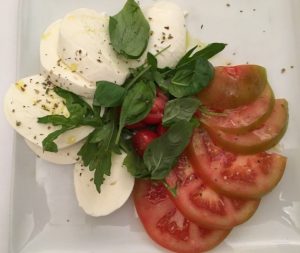
A lovely, light insalata Caprese served at Obica, a mozzarella bar in downtown Rome.
Rome is one of those cities that explodes with opportunity to enjoy art, architecture, history, archaeology, anthropology, food, beauty, friends. And as my trip came to a close, I recognize how much more I understand Rome’s past and present and am eager to keep reading until my next trip
What are some of your favorite titles to read for which places?
